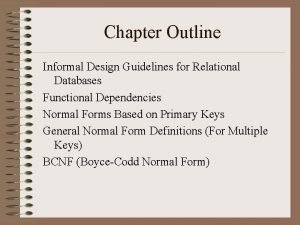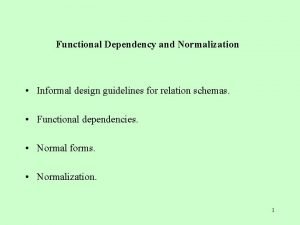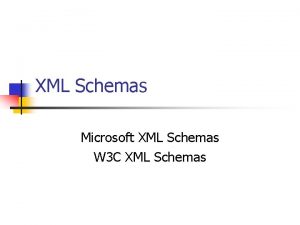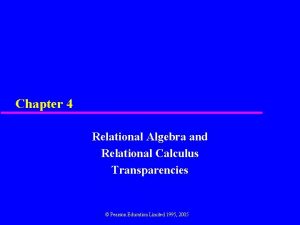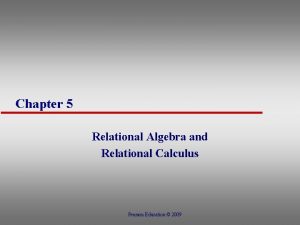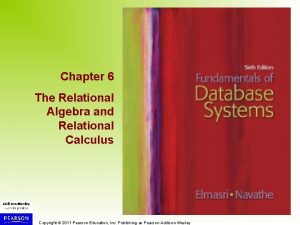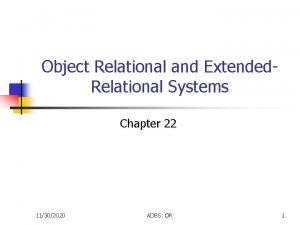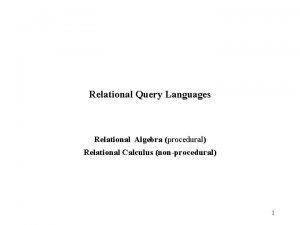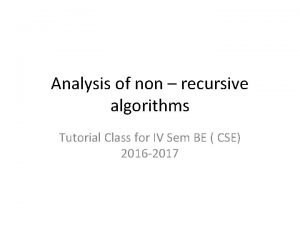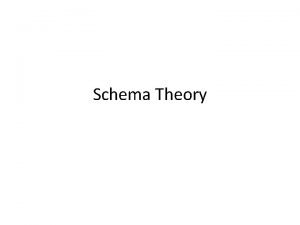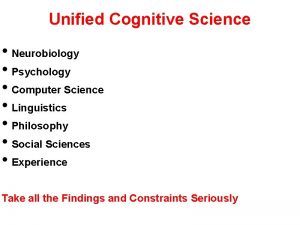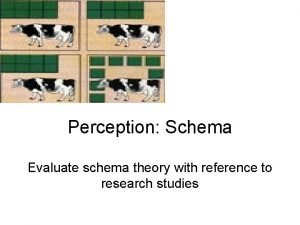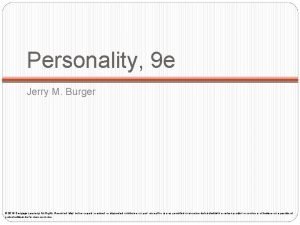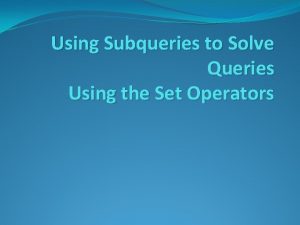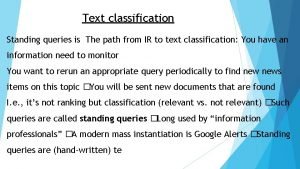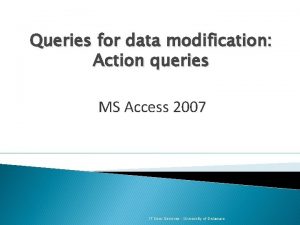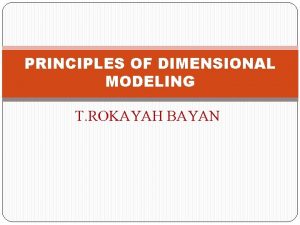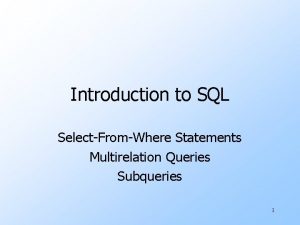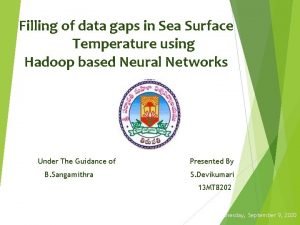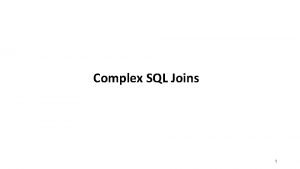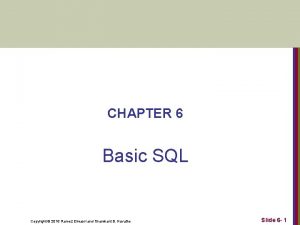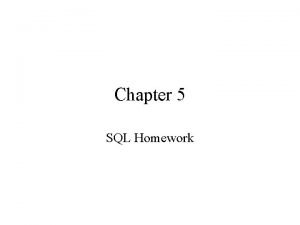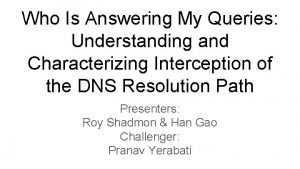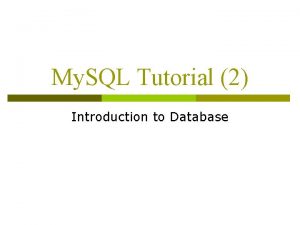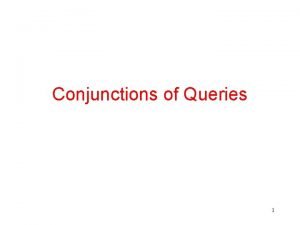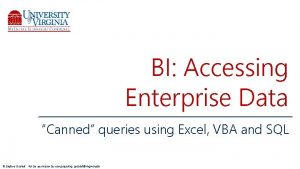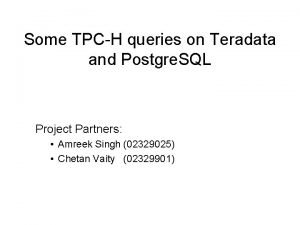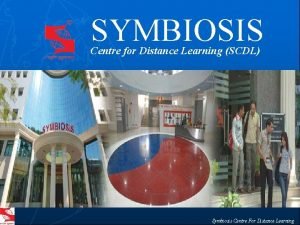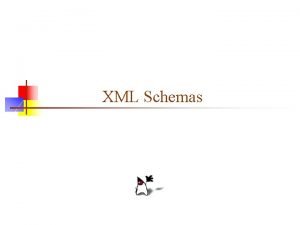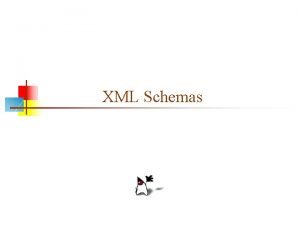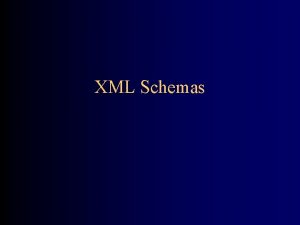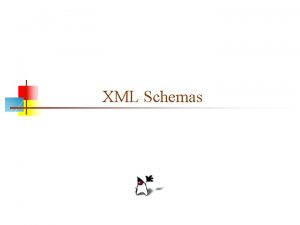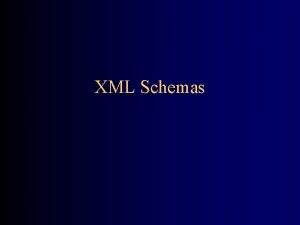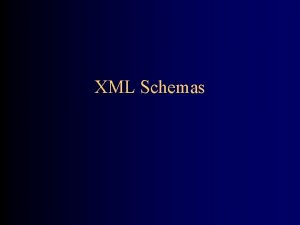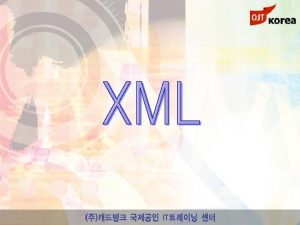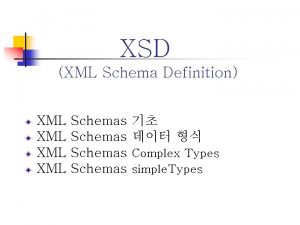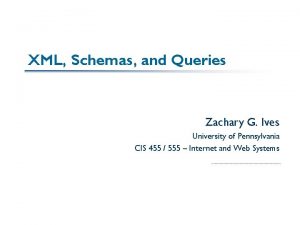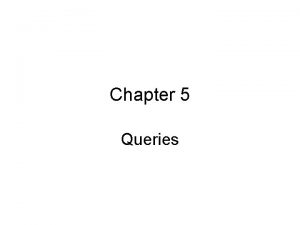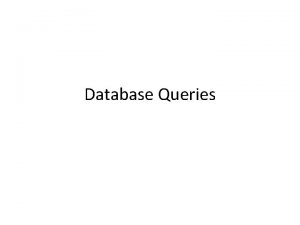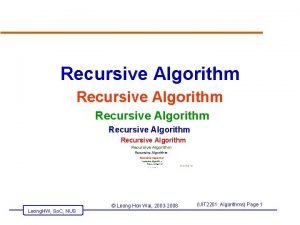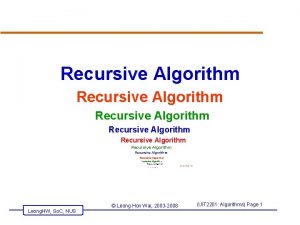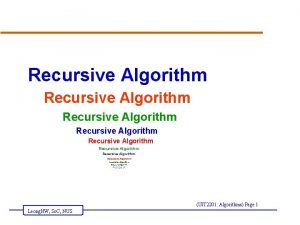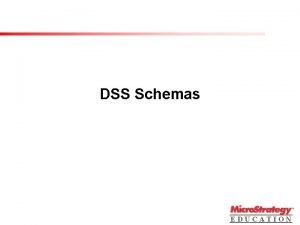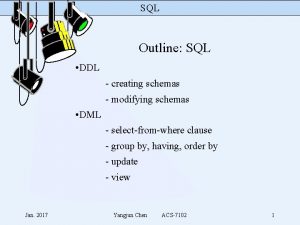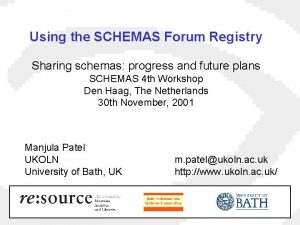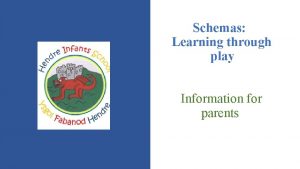Recursive XML Schemas Recursive XML Queries and Relational


































- Slides: 34

Recursive XML Schemas, Recursive XML Queries, and Relational Storage: XML-to-SQL Query Translation Krishnamurthy, R. , Chakaravarthy, V. T. , Kaushik, R. , & Naughton, J. F. (2004) Proceedings of the 20 th International Conference on Data Engineering (ICDE’ 04) Presenter: Jochen Stoesser mailto: jstoesse@connect. carleton. ca April 5, 2005 Advanced Database Systems, Jochen Stoesser

Motivation (1) • General topic: XML-to-SQL query translation • 3 scenarios of XML shredding § schema-oblivious shredding § XML Publishing § schema-based shredding April 5, 2005 Advanced Database Systems, Jochen Stoesser 2

Motivation (2): Schema Graph • Tree schema graph (see example) • directed acyclic (DAG) schema graph multiple incoming edges • recursive schema graph Source: Krishnamurthy et al. (2004) April 5, 2005 Advanced Database Systems, Jochen Stoesser 3

Motivation (3): Schema-based Shredding • for each non-leaf node create separate relation § Book(id, title) § Author(id, parentid) § Section(id, parentcode, title) § Para(id, parentid) § Figure(id, parentid, caption, image) • each leaf node is associated with a column name • parentid and parentcode to preserve structure April 5, 2005 Advanced Database Systems, Jochen Stoesser 4

Motivation (4) • Focus of the paper: XML-to-SQL query translation with schema-based shredding, especially in the presence of § recursive XML query, e. g. /book//section/title // /descendant-or-self: : node()/ § • recursive XML schemas (>> example) not solved by § existing schema-based shredding algorithms, § schema-oblivious shredding algorithms, § XML Publishing algorithms April 5, 2005 Advanced Database Systems, Jochen Stoesser 5

Queries: SQL(p) • example: retrieve nodes 9 (titles of subsections, i. e. nodes 7) /book/section/title • path p = <book, section(4), section(7), title> • SQL(p): select from where S 2. title Book B, Section S 1, Section S 2 B. id=S 1. parentid and S 1. parentcode=1 and S 1. id=S 2. parentid and S 2. parentcode=2; >> April 5, 2005 Advanced Database Systems, Jochen Stoesser 6

Queries: Rto. L(l) • root-to-leaf SQL query • possibly multiple root-to-leaf paths p 1, . . . , pm to leaf l • Rto. L(l) : = • retrieves all information that would be retrieved traversing all paths from the root to leaf l • Problem: recursive schema possibly infinite number of root-to-leaf paths Rto. L query: union of infinitely many queries April 5, 2005 Advanced Database Systems, Jochen Stoesser * 7

Query Translation • two stages: 1. Identify the paths in the XML schema graph that satisfy the query: Path. Id stage 2. Use annotations (schemas) from XML-to-Relational mapping to construct equivalent relational query: SQLGen stage XML schema Path. Id Mapping schema SQLGen SQL query XML query April 5, 2005 Advanced Database Systems, Jochen Stoesser 8

Path. Id Stage • Problems: § recursive schema: number of paths possibly infinite § DAG graph: exponential number of paths • General idea: § Represent matching paths as graph instead of enumerating to reflect shared information across multiple paths (will become important for SQLGen stage) § execute query on a schema graph and identify statisfying paths April 5, 2005 Advanced Database Systems, Jochen Stoesser 9

Path. Id Stage • Algorithm outline: § Take automaton AS representing schema graph S § Translate Query into DFA AQ § Create cross-product automaton ASQ from AS and AQ, eliminate all dead states § ASQ contains all matching paths § View ASQ as mapping schema SSQ >> April 5, 2005 Advanced Database Systems, Jochen Stoesser 10

Path. Id Stage: XPath Semantics Query: //section//title Source: Krishnamurthy et al. (2004) April 5, 2005 Advanced Database Systems, Jochen Stoesser 11

SQLGen Stage XML schema Path. Id Mapping schema SQLGen XML query • informally: union of all Rto. L in mapping schema SSQ corresponds to query result • problem: DAG and recursive graphs & queries § DAG: number of paths can be exponential in the size of the component § recursive graphs & queries: infinite number of matching paths April 5, 2005 Advanced Database Systems, Jochen Stoesser 12

SQLGen Stage • Solution: SQL 99 with-clause • Used to create temporary relations for • Nodes in DAG components shared computation, reflects shared information contained in paths through DAG components decrease exponential to polynomial complexity! • Recursive components >> April 5, 2005 Advanced Database Systems, Jochen Stoesser 13

SQLGen: Algorithm (1) • Query: /E 0//E 10 c 1 • Find mapping schema SSQ (S=SSQ) c 2 • strongly connected, non-recursive components (i = Ei): {0}, {1}, {2}, {3}, {4}, {5}, {6}, {10}, {11} • merge adjacent components ci and cj if ci dominates cj c 3 c 1 = {0, 1, 2, 3, 4, 5, 6}, c 3 = {10, 11} E 11 • recursive component c 2 = {7, 8, 9} Source: Krishnamurthy et al. (2004) April 5, 2005 Advanced Database Systems, Jochen Stoesser 14

SQLGen: Algorithm (2), DAG components • further process in top-down topological order • c 1 = {0, 1, 2, 3, 4, 5, 6} non-recursive DAG component • create temporary relation for each non-root node that is § leaf node § has child or parent in different component § multiple incoming/outgoing edges ( shared computation) • N 1 = {2, 3, 6} >> April 5, 2005 c 1 Advanced Database Systems, Jochen Stoesser 15

SQLGen: Algorithm (3), DAG components • for example for node E 6 N 1: shared computation with T 6 as ( select R 6. * from R 4, T 3 where R 4. id=R 6. parentid and T 3. id=R 4. parentid and R 6. parentcode=1 union all select R 6. * from R 5, T 3 where R 5. id=R 6. parentid and T 3. id=R 5. parentid and R 6. parentcode=2 ) April 5, 2005 Advanced Database Systems, Jochen Stoesser 16

SQLGen: Algorithm (4), recursive components • c 2 = {7, 8, 9} recursive component • temporary relation TR, schema is union of the schemas of nodes in TR • two parts: 1. Initialization part captures all incoming edges 2. Recursive part captures recursion >> April 5, 2005 Advanced Database Systems, Jochen Stoesser 17

SQLGen: Algorithm (5), initialization • incoming edges from other components: (2, 8) and (3, 7) shared computation • Q 1 = select R 8. *, id(8) as schemanode from T 2, R 8 where R 8. parentcode=2 and R 8. parentid=T 2. id • Q 2 = select R 7. *, id(7) as schemanode from T 3, R 7 where R 7. parentcode=3 and R 7. parentid=T 3. id • Qinit = Q 1 Q 2 April 5, 2005 Advanced Database Systems, Jochen Stoesser 18

SQLGen: Algorithm (6), recursion • edges within the recursive component c 2: (7, 9), (8, 7), (8, 9), (9, 8) • construct recursive query for each of these edges, e. g. Qe 1=(7, 9) = select R 9. *, id(9) as schemanode from TR, R 9 where TR. schemanode=id(7) and R 9. parentid=TR. id and R 9. parentcode=1 • recursive part TR = Qinit QR • for each n c 2: temporary relation T(n) = select * from TR where schemanode=id(n) (>> example) April 5, 2005 Advanced Database Systems, Jochen Stoesser 19

SQLGen: Final Query • result of SQLGen stage: § temporary relations - T 2, T 3, T 6 for c 1 - T 7, T 8, T 9, and TR for c 2 - T 10 and T 11 for c 3 § Final query: § /E 0//E 10 algorithm select elemid from T 11 April 5, 2005 Advanced Database Systems, Jochen Stoesser 20

Empirical Evaluation (1) • XMark Benchmark schema • Translation of query fragments that appear in query suite • XML-to-Relational mapping schema has 101 nodes • Size of cross-product schema in all cases < 100 nodes • Result: Translation processes for each query < 6 ms April 5, 2005 Advanced Database Systems, Jochen Stoesser 21

Empirical Evaluation (2) • test under extreme conditions • all transitions on single label x • query //x//x//x • mapping schema complete graph (clique) of n nodes • runtime of translation algorithm: Source: Krishnamurthy et al. (2004) April 5, 2005 Advanced Database Systems, Jochen Stoesser 22

Contributions • Claim: „first to present a generic algorithm that translates path expression queries to SQL in the presence of recursion in the schema in the context of schema-based XML storage shredding of XML into relations“ • Algorithm translates a path expression query into a single SQL query, irrespective of the XML schema‘s complexity • SQL query‘s size polynomial in size of the input XML-to. Relational mapping and the XML query April 5, 2005 Advanced Database Systems, Jochen Stoesser 23

Limitations • High complexity of SQL query even for relatively easy XML queries • Although running time may be small, memory requirements may be high due to many temporary relations • Furthermore, although authors indicate solutions for XPath semantics and branching path expression queries (e. g. p 1[p 2 op value]), there is no proposition about increase in complexity regarding runtime, memory requirements etc. April 5, 2005 Advanced Database Systems, Jochen Stoesser 24

Q&A ? April 5, 2005 Advanced Database Systems, Jochen Stoesser 25

References • Krishnamurthy, R. (2004) XML-to-SQL Query Translation. Dissertation at the University of Wisconsin-Madison. Retrieved at March 18 from http: //www. cs. wisc. edu/~sekar/research/main. pdf • XPath v 1. 0. W 3 C. Retrieved at March 18 from http: //www. w 3. org/TR/1999/REC-xpath-19991116. html • Tian, F. , De. Witt, D. J. , Chen, J. , & Zhang, C. The Design and Performance Evaluation of Alternative XML Storage Strategies. Retrieved at April 4 from http: //www. cs. wisc. edu/~czhang/doc/publications/feng 6 page. pdf April 5, 2005 Advanced Database Systems, Jochen Stoesser 26

Appendix: Recursive XML Schema <? xml version="1. 0" encoding="UTF-8"? > <xs: schema xmlns: xs="http: //www. w 3. org/2001/XMLSchema" version="1. 0"> <xs: element name="element"> <xs: complex. Type> <xs: sequence> <xs: any process. Contents="skip" min. Occurs="0" /> <xs: element ref="element" min. Occurs="0" /> </xs: sequence> * </xs: complex. Type> </xs: element> element </xs: schema> << April 5, 2005 Advanced Database Systems, Jochen Stoesser 27

Appendix: SQL(path p) << April 5, 2005 Advanced Database Systems, Jochen Stoesser 28

Appendix: Path. Id(Q, S) << April 5, 2005 Advanced Database Systems, Jochen Stoesser 29

Appendix: SQLGen(SSQ) << April 5, 2005 Advanced Database Systems, Jochen Stoesser 30

Appendix: SQLFrom. DAG(c) << April 5, 2005 Advanced Database Systems, Jochen Stoesser 31

Appendix: SQLFrom. Recursive(c) (1) April 5, 2005 Advanced Database Systems, Jochen Stoesser 32

Appendix: SQLFrom. Recursive(c) (2) << April 5, 2005 Advanced Database Systems, Jochen Stoesser 33

Appendix: TR example << April 5, 2005 Advanced Database Systems, Jochen Stoesser 34
 Informal design guidelines
Informal design guidelines Informal design guidelines for relational schemas
Informal design guidelines for relational schemas Microsoft max
Microsoft max Relational algebra and relational calculus
Relational algebra and relational calculus Relational algebra and relational calculus
Relational algebra and relational calculus Relational algebra and relational calculus
Relational algebra and relational calculus Object relational and extended relational databases
Object relational and extended relational databases Relational calculus is a procedural language
Relational calculus is a procedural language Non recursive algorithms
Non recursive algorithms Brewer and treyens (1981)
Brewer and treyens (1981) Sql queries for insert update and delete
Sql queries for insert update and delete Suggestions and queries
Suggestions and queries What is schema
What is schema What is a schema
What is a schema Reference
Reference Self schemas
Self schemas Using subqueries to solve queries
Using subqueries to solve queries Standing query
Standing query Action queries in access
Action queries in access Principles of dimensional modeling
Principles of dimensional modeling Multirelation queries
Multirelation queries Wildcard queries in information retrieval
Wildcard queries in information retrieval Any queries
Any queries Complex sql join queries
Complex sql join queries Basic retrieval queries in sql
Basic retrieval queries in sql Hotel.hotelno=room.hotelno(hotel room)
Hotel.hotelno=room.hotelno(hotel room) Answering my queries
Answering my queries Wide world importers sample database
Wide world importers sample database Sql queries for banking database
Sql queries for banking database Conjunctive queries
Conjunctive queries Canned queries
Canned queries Ingres algorithm
Ingres algorithm Tpch queries
Tpch queries For any queries
For any queries Exam queries scdl
Exam queries scdl
